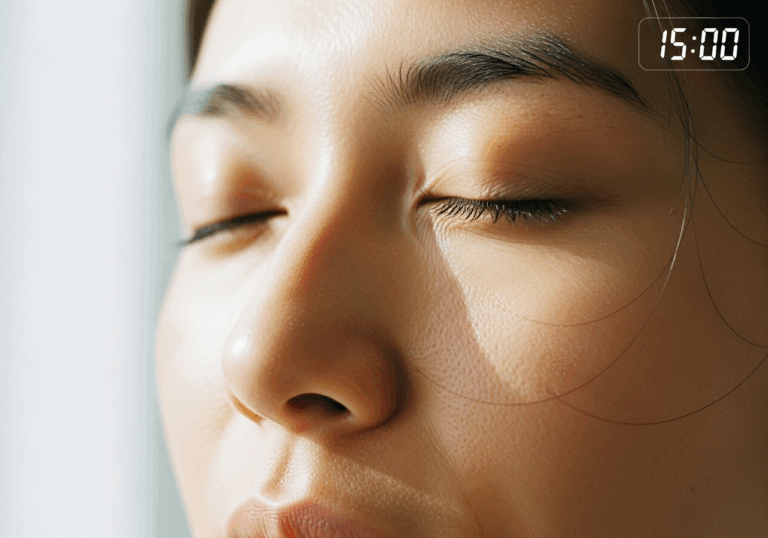Science-Backed Tips
Breathe Better: The 4-7-8 Technique
Reduce heart rate and cortisol by practicing 4-7-8 breathing.
📊 Did you know?
💡 Why It Matters
1️⃣
Lowering cortisol by 20% can significantly reduce stress-related health issues.
2️⃣
Improved emotional regulation can enhance sleep quality, leading to better overall health.
3️⃣
Structured breathing techniques like 4-7-8 can be easily integrated into daily routines for stress management.
✅ Try These Micro-Tips
🎯
Practice the 4-7-8 breathing technique for 10 minutes before bedtime.
🎯
Inhale for 4 seconds, hold for 7 seconds, and exhale for 8 seconds, repeating this cycle.
🎯
Incorporate this technique into your daily routine, aiming for at least once a day.
🎯
Track your heart rate and stress levels before and after practicing to measure improvement.
📚 The study
This technique involves inhaling for four seconds, holding the breath for seven seconds, and exhaling for eight seconds.
Observational reviews have shown that practicing this structured, exhale-dominant breathing can lead to a significant reduction in heart rate and anxiety levels, with cortisol levels dropping by up to 20%.
Such a decrease in cortisol is crucial, as it can mitigate various stress-related health issues.
Moreover, improved emotional regulation through this technique can lead to better sleep quality, which is essential for overall health and well-being.
The beauty of the 4-7-8 technique lies in its simplicity; it can be easily incorporated into daily routines, making it an accessible tool for anyone looking to manage stress effectively.
By integrating this breathing practice into your pre-bedtime routine, you can create a calming environment that promotes relaxation and prepares your body for restful sleep.
In a world where stress is prevalent, adopting such mindful breathing techniques can be a game-changer for your mental and physical health.
❓ Frequently Asked Questions ❓
Learn more
What is the 4-7-8 breathing technique?
The 4-7-8 breathing technique involves inhaling for 4 seconds, holding the breath for 7 seconds, and exhaling for 8 seconds. This structured breathing method is designed to promote relaxation and emotional regulation.
How does the 4-7-8 technique affect heart rate?
Practicing the 4-7-8 technique has been shown to lower heart rate significantly. This reduction in heart rate can contribute to improved emotional regulation and stress management.
What impact does 4-7-8 breathing have on cortisol levels?
The 4-7-8 breathing technique can reduce cortisol levels by up to 20%. Lower cortisol levels are associated with decreased stress-related health issues.
When is the best time to practice 4-7-8 breathing?
The best time to practice 4-7-8 breathing is before bedtime. This technique can help improve sleep quality and promote relaxation.
How long should I practice the 4-7-8 technique?
It is recommended to practice the 4-7-8 technique for at least 10 minutes. Consistency is key, so aim to incorporate it into your daily routine.
Can I track my progress with the 4-7-8 technique?
Yes, you can track your heart rate and stress levels before and after practicing the 4-7-8 technique. Monitoring these metrics can help you measure improvement over time.
Is the 4-7-8 breathing technique suitable for everyone?
The 4-7-8 breathing technique is generally safe for most individuals. However, those with respiratory issues or other health concerns should consult a healthcare professional before starting any new breathing exercises.
How does structured breathing help with emotional regulation?
Structured breathing techniques like 4-7-8 shift the autonomic nervous system balance, which aids in mood regulation. This can lead to improved emotional stability and reduced anxiety.
Can I integrate 4-7-8 breathing into my daily routine?
Yes, the 4-7-8 breathing technique can be easily integrated into your daily routine. Aim to practice it at least once a day for optimal benefits.
What are the overall health benefits of practicing 4-7-8 breathing?
Practicing 4-7-8 breathing can lead to lower heart rate, reduced cortisol levels, and improved emotional regulation. These benefits contribute to better sleep quality and overall health.





